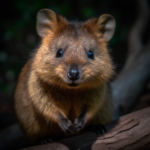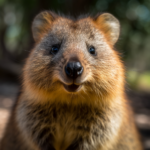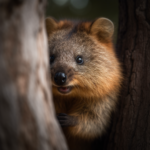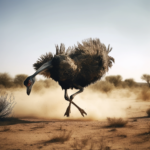Quokka Poop: A Fascinating Insight into the Droppings of Australia’s Happiest Animal
Quokkas, those adorable and photogenic creatures native to Western Australia, have captured the hearts of people around the world. Known as the “happiest animal on Earth,” these small marsupials are famous for their friendly and approachable nature. However, there’s more to quokkas than just their charming smiles and playful antics. In this article, we will delve into a rather unusual topic – quokka poop. Yes, you read that right! Quokka droppings may not be the first thing that comes to mind when thinking about these delightful creatures, but they offer valuable insights into their diet, behavior, and role in the ecosystem. So, let’s dive in and explore the world of quokka poop together!
Key Takeaways
- Quokka poop is an important part of the ecosystem as it helps in seed dispersal and nutrient cycling.
- Quokka poop is small, pellet-like, and often found in communal latrines.
- Studying quokka poop can provide insights into their diet, health, and population dynamics.
- Quokka poop is not harmful to humans and can be used as a natural fertilizer.
Understanding the Quokka: A Brief Overview
A. How to Pronounce ‘Quokka’
The name ‘quokka’ might sound a bit peculiar, but it’s actually quite simple to pronounce. The word is pronounced as “kwah-kuh.” The emphasis is on the first syllable, and the ‘o’ is pronounced as a short ‘o’ sound, similar to the ‘o’ in ‘hot.’ So, it’s not ‘kwo-kah’ or ‘koo-ka,’ but rather ‘kwah-kuh.’ Now that we’ve got the pronunciation down, let’s delve into the fascinating world of quokkas.
B. Quokka’s Natural Habitat: Where is Quokka From?
Quokkas are native to Western Australia, specifically found in the southwestern part of the state. They primarily inhabit Rottnest Island, which is located just off the coast of Perth. These adorable creatures can also be found on some parts of the mainland, including the forests and coastal areas of Western Australia.
C. Are Quokkas Soft? An Insight into their Physical Attributes
Quokkas are small marsupials, measuring around 16 to 21 inches in length, with a tail that adds an additional 9.8 to 11.8 inches. They have a stocky build and are covered in a dense, coarse fur that ranges in color from brown to gray. While their fur might not be as soft as a rabbit‘s, it still has a certain level of softness to it.
Their round faces are adorned with a cute button-like nose, small ears, and dark, expressive eyes. Quokkas also have a unique feature called a “cheek pouch,” which allows them to store food for later consumption. These pouches are located on the sides of their mouths and can expand to accommodate a significant amount of food.
D. Can a Quokka Quack? Debunking Myths
There is a popular misconception that quokkas make a quacking sound, hence their nickname “the happiest animal on Earth.” However, this is not true. Quokkas do not quack like ducks or make any similar sounds. In fact, they are relatively quiet creatures, communicating mostly through body language and scent marking.
Quokkas are known for their friendly and curious nature, which has led to the misconception that they are always smiling. While they do have a naturally upturned mouth that gives the appearance of a smile, it’s important to remember that this is just their facial structure and not an indication of their emotional state.
In conclusion, quokkas are fascinating creatures that have captured the hearts of many. From their unique habitat on Rottnest Island to their adorable physical attributes, there is much to learn and appreciate about these small marsupials. So, the next time you come across a quokka, remember to pronounce their name correctly and admire their cuteness from a respectful distance.
The Quokka Diet: What and How Much Do Quokkas Eat?

Quokkas, the adorable marsupials native to Western Australia, have a unique diet that plays a crucial role in their overall health and well-being. In this section, we will delve into the details of what quokkas eat and how much they consume on a daily basis. Additionally, we will also explore the predators that pose a threat to these gentle creatures.
A. What Do Quokkas Eat: A Detailed Analysis
Quokkas are herbivores, meaning their diet primarily consists of plant matter. They have a diverse palate and consume a variety of vegetation found in their natural habitat. Some of the key components of a quokka‘s diet include:
-
Grasses: Quokkas graze on a range of grasses that grow abundantly in their environment. These grasses provide them with essential nutrients and fiber.
-
Leaves and Shrubs: Quokkas also feed on leaves and shrubs, which contribute to their nutritional intake. They have been observed munching on the leaves of various plants, including coastal heathland species.
-
Bark: In certain instances, quokkas may nibble on the bark of trees. While this behavior is not as common as their consumption of grasses and leaves, it highlights their adaptability in finding sustenance.
-
Fruits: Quokkas have a sweet tooth for fruits. They relish the opportunity to snack on fallen fruits, such as berries and seeds, when available. This adds a burst of flavor and additional nutrients to their diet.
B. How Much Do Quokkas Eat a Day: Understanding their Eating Habits
Quokkas are known for their efficient eating habits. Despite their small size, they consume a substantial amount of food each day to meet their energy requirements. On average, a quokka consumes approximately 200 grams of vegetation daily. This amount may vary depending on factors such as the availability of food sources and the individual quokka’s metabolic needs.
Quokkas have a unique ability to extract maximum nutrition from the limited resources available in their habitat. Their digestive system is designed to efficiently process plant matter, allowing them to extract essential nutrients and energy from their diet.
C. What Eats Quokkas: The Predators in Focus
While quokkas may seem irresistibly cute, they do face threats from predators in their natural environment. Some of the predators that pose a danger to quokkas include:
-
Feral Cats: Feral cats, introduced to the region by humans, are one of the primary predators of quokkas. These agile hunters pose a significant threat to the quokka population, especially the young and vulnerable individuals.
-
Dogs: Domestic dogs, when unleashed and uncontrolled, can also pose a risk to quokkas. It is important for dog owners to be responsible and keep their pets on a leash when in quokka-inhabited areas.
-
Birds of Prey: Birds of prey, such as eagles and owls, are skilled hunters that can target quokkas as a food source. Their aerial prowess and sharp talons make them formidable predators.
-
Snakes: Certain snake species, like the dugite and tiger snake, are known to prey on quokkas. These reptiles are venomous and can pose a significant threat to quokka populations.
Efforts are being made to protect quokkas from these predators through conservation initiatives and the establishment of protected areas. These measures aim to ensure the long-term survival of these unique and endearing creatures.
In conclusion, understanding the dietary habits of quokkas is essential for their conservation and well-being. By preserving their natural habitat and protecting them from predators, we can help ensure a thriving population of these delightful marsupials for generations to come.
The Fascinating World of Quokka Poop

A. What Does Quokka Poop Look Like: A Descriptive Study
Quokkas, those adorable and photogenic marsupials native to Western Australia, have a lot more to offer than just their charming smiles. One aspect of their lives that often goes unnoticed is their poop. Yes, you heard it right – quokka poop! In this section, we will take a closer look at what quokka poop looks like and explore its significance in understanding these fascinating creatures.
When it comes to describing quokka poop, it can vary in appearance depending on various factors such as their diet and habitat. Generally, quokka droppings are small, cylindrical pellets, similar in size to those of a rabbit. They are usually dark brown or black in color, which is a result of the digestion process.
Quokka scat is typically found scattered around their habitat, including the dense vegetation and shrubs they inhabit. These droppings play an essential role in marking their territory and communicating with other quokkas. By leaving their scat in strategic locations, quokkas can establish their presence and assert their dominance.
B. What Shape is Quokka Poop: Unveiling the Mystery
The shape of quokka poop is a topic that has intrigued researchers and wildlife enthusiasts alike. While it is commonly believed that quokka poop is spherical or round, this is not entirely accurate. Quokka droppings are actually cylindrical in shape, resembling small pellets.
The cylindrical shape of quokka poop is a result of their unique digestive system. Quokkas are herbivores, primarily feeding on grasses, leaves, and other plant material. Their digestive system is designed to efficiently process these fibrous foods, resulting in the formation of compact cylindrical pellets.
The size of quokka droppings can vary, but they are generally around 1-2 centimeters in length. This compact shape allows quokkas to efficiently eliminate waste and maintain a clean and hygienic environment in their habitat.
C. Quokka Poop Chocolate: A Misconception or Reality?
You may have come across claims that quokka poop is used to make chocolate. However, let’s debunk this misconception once and for all. Quokka poop chocolate is not a reality. It is merely a myth that has gained popularity due to its quirky and intriguing nature.
The idea of quokka poop chocolate likely originated from the fact that quokkas are known to have a sweet tooth. These adorable marsupials have been observed munching on sweet fruits and berries, which may have led to the misconception that their poop could be used to make chocolate.
In reality, chocolate is made from cocoa beans, which are harvested from the cacao tree. Quokka poop has no involvement in the chocolate-making process whatsoever. So, if you come across any claims of quokka poop chocolate, take them with a grain of salt and enjoy your regular, poop-free chocolate instead!
D. Quokka Poop vs Wombat Poop: The Key Differences
Quokka poop and wombat poop may seem similar at first glance, but there are some key differences between the two. Both quokkas and wombats are marsupials and have similar diets, primarily consisting of vegetation. However, their digestive systems and resulting droppings have distinct characteristics.
Quokka poop, as mentioned earlier, is cylindrical in shape and relatively small in size. On the other hand, wombat poop is more unique and fascinating. Wombat droppings are cube-shaped, which is a remarkable feat in the animal kingdom. The reason behind this peculiar shape is still a subject of scientific study.
Another noticeable difference is the color of the droppings. Quokka poop is usually dark brown or black, while wombat poop tends to be lighter in color, ranging from brown to greenish-brown. These variations in color can be attributed to differences in their diets and digestive processes.
In conclusion, while both quokka poop and wombat poop are intriguing in their own right, they have distinct characteristics that set them apart. Understanding these differences can provide valuable insights into the digestive systems and behaviors of these unique Australian marsupials.
The Science Behind Poop Formation
A. How is Poop Made in the Body: A Biological Perspective
Have you ever wondered how poop is formed in the body? It may not be the most glamorous topic, but understanding the science behind poop formation can provide valuable insights into our overall health and well-being.
The process of poop formation begins in the digestive system, where food is broken down and nutrients are extracted. As we consume food, it travels through the esophagus and into the stomach, where it is mixed with digestive enzymes and acids. From there, it moves into the small intestine, where the majority of nutrient absorption takes place.
In the small intestine, the body absorbs essential nutrients such as carbohydrates, proteins, and fats. These nutrients are then transported to various cells and tissues to provide energy and support bodily functions. However, not all of the food we consume can be fully digested and absorbed.
The undigested food particles, along with waste products and bacteria, continue their journey into the large intestine, also known as the colon. Here, the colon‘s main function is to absorb water and electrolytes from the remaining waste material. As water is absorbed, the waste becomes more solid and takes on the familiar form of poop.
The colon is also home to trillions of beneficial bacteria, collectively known as the gut microbiota. These bacteria play a crucial role in the final stages of poop formation. They help break down any remaining undigested food particles, produce certain vitamins, and contribute to the overall health of the digestive system.
Once the waste material has been processed in the colon, it is stored in the rectum until it is ready to be eliminated from the body. The rectum acts as a temporary storage facility for poop, allowing us to control when and where we release it.
B. How Much Poop is in Me: A Human Perspective
Now that we understand how poop is formed in the body, you might be curious about how much poop is actually inside you at any given time. On average, a healthy adult produces about 100 to 200 grams of poop per day. However, this can vary depending on factors such as diet, hydration, and individual metabolism.
It’s important to note that the weight of poop is not solely comprised of waste material. The majority of poop is actually made up of water, which is why it’s crucial to stay hydrated to maintain healthy bowel movements. Other components of poop include undigested food particles, dead cells, bacteria, and bile.
The frequency of bowel movements can also vary from person to person. While some individuals may have a bowel movement once or twice a day, others may go every other day or even less frequently. As long as you are not experiencing any discomfort or irregularities, the frequency of your bowel movements is generally considered normal.
C. How is Poop Treated: An Environmental Perspective
Once poop has been eliminated from the body, it enters the realm of waste management and environmental considerations. Proper treatment and disposal of poop are essential to maintain sanitation and prevent the spread of diseases.
In urban areas, sewage systems are designed to collect and transport poop to wastewater treatment plants. Here, the poop undergoes a series of processes to remove harmful bacteria, viruses, and other contaminants. The treated wastewater is then released back into the environment, often into rivers or oceans, where it undergoes further natural purification.
In more remote or rural areas, where sewage systems may not be available, alternative methods of poop treatment are employed. These can include septic tanks, composting toilets, or other decentralized systems. These methods aim to safely contain and treat poop, minimizing the impact on the environment and human health.
It’s worth mentioning that animal poop, including quokka poop, also plays a vital role in the ecosystem. Animal droppings contribute to nutrient cycling, seed dispersal, and soil fertility. In the case of quokkas, their poop helps fertilize the soil, promoting the growth of vegetation that sustains other wildlife in their habitat.
Understanding the science behind poop formation, the amount of poop in our bodies, and the importance of proper poop treatment can help us appreciate the intricate processes that occur within our bodies and the environment. So, the next time you ponder the mysteries of poop, remember that it’s not just a waste product but a fascinating aspect of our biology and the natural world around us.
The Quokka’s Happiness Quotient
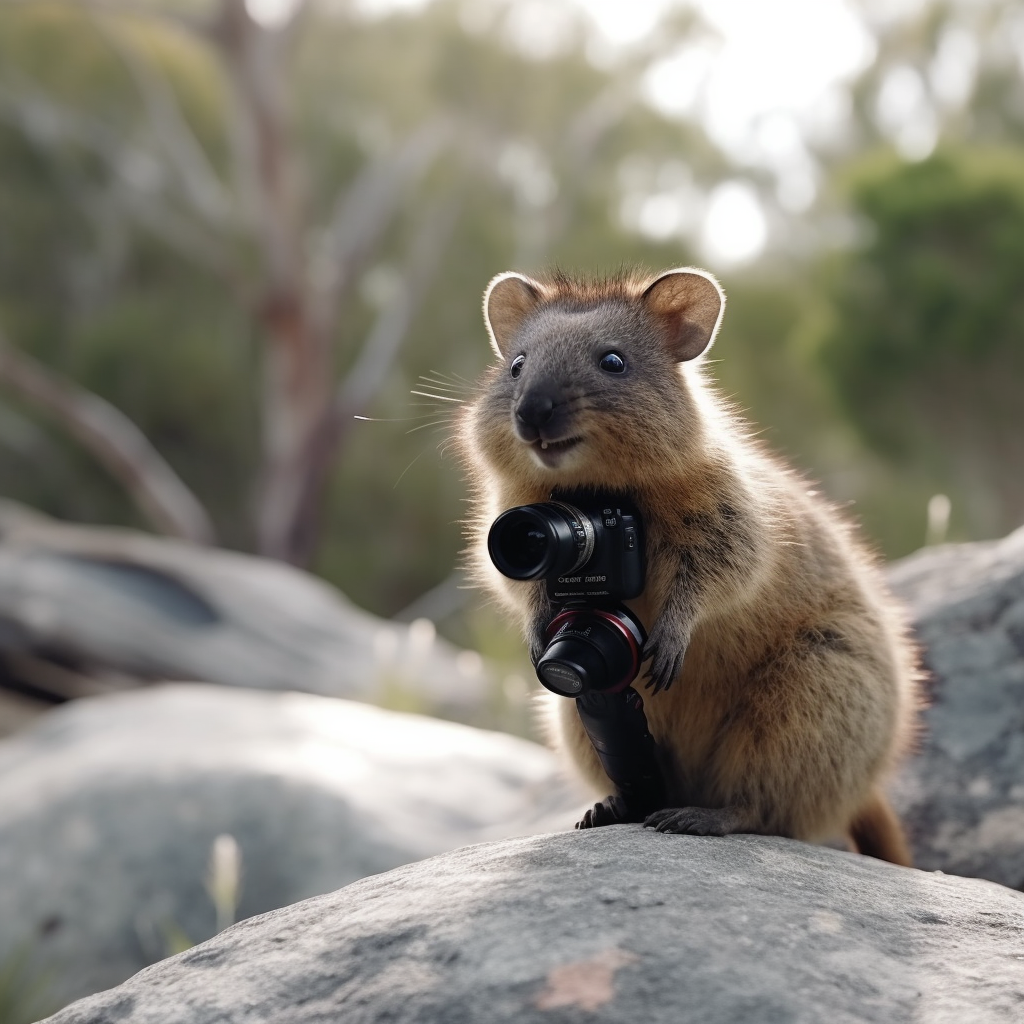
A. Quokka Happy: Understanding the ‘World’s Happiest Animal’
When it comes to happiness, the quokka holds a special place in the animal kingdom. Known as the “world’s happiest animal,” these small marsupials have captured the hearts of people around the globe with their adorable smiles and friendly demeanor. But what exactly makes the quokka so happy?
1. Natural Behavior and Social Interactions
One of the key factors contributing to the quokka‘s happiness is its natural behavior and social interactions. Quokkas are highly social animals, living in close-knit communities and engaging in playful interactions with their fellow quokkas. These social bonds provide a sense of belonging and companionship, which undoubtedly contributes to their overall happiness.
2. Lack of Natural Predators
Another reason for the quokka‘s happiness is the absence of natural predators on Rottnest Island, their primary habitat. With no significant threats to their safety, quokkas can roam freely and without fear, leading to a more relaxed and contented existence. This freedom from constant danger allows them to focus on their daily activities and enjoy their surroundings.
3. Abundance of Food and Water
Quokkas have a varied diet consisting of grasses, leaves, bark, and even small insects. The abundance of food sources on Rottnest Island ensures that quokkas have a consistent and nutritious diet, which plays a vital role in their overall well-being and happiness. Access to clean water is also crucial for their survival and contributes to their overall contentment.
B. The Influence of Diet on Quokka’s Happiness
The saying “you are what you eat” holds true for quokkas as well. The diet of these adorable marsupials has a direct impact on their happiness and overall health. Let’s take a closer look at how diet influences the happiness of quokkas.
1. Nutritional Balance
A well-balanced diet is essential for the overall health and happiness of quokkas. Their diet consists of a variety of plant matter, including grasses, leaves, and bark. These food sources provide the necessary nutrients, vitamins, and minerals that quokkas need to thrive. A balanced diet ensures that quokkas have the energy and vitality to engage in their natural behaviors and social interactions, contributing to their happiness.
2. Digestive Health
Quokkas have a unique digestive system that allows them to efficiently extract nutrients from their food. A healthy digestive system ensures that quokkas can digest their food properly, absorb essential nutrients, and eliminate waste effectively. Any disruptions in their digestive health can lead to discomfort and unhappiness. Therefore, a diet that supports optimal digestive function is crucial for the well-being of quokkas.
3. Hydration
Proper hydration is vital for the happiness and overall health of quokkas. Quokkas obtain water from various sources, including dew, succulent plants, and natural water bodies. Adequate hydration helps regulate body temperature, aids digestion, and ensures proper organ function. Quokkas that have access to clean and sufficient water sources are more likely to be happy and content.
In conclusion, the happiness of quokkas is influenced by a combination of factors, including their natural behavior, social interactions, lack of natural predators, abundance of food and water, and a well-balanced diet. Understanding these factors can help us appreciate and protect these delightful creatures, ensuring their continued happiness and well-being in their natural habitat. Conclusion
In conclusion, quokka poop may not be the most glamorous topic, but it is certainly an interesting one. These small marsupials have unique digestive systems that allow them to efficiently extract nutrients from their food, resulting in small, pellet-like droppings. Quokka poop plays an important role in the ecosystem, as it helps to disperse seeds and fertilize the soil. Additionally, studying quokka poop can provide valuable insights into their diet and overall health. So, the next time you come across quokka poop while exploring the beautiful landscapes of Western Australia, take a moment to appreciate the important role it plays in the quokka‘s life and the environment as a whole.
Frequently Asked Questions
What does quokka poop look like?
Quokka poop is typically small, round, and dark in color. It is not square or cube-shaped like wombat poop.
Is it true that quokka poop looks like chocolate?
No, this is a misconception. Quokka poop is dark in color but it does not resemble chocolate in any other way. It is important to remember that it is a waste product and should not be consumed.
What animals prey on quokkas?
Quokkas have few natural predators on Rottnest Island, their primary habitat. However, they can fall prey to birds of prey, snakes, and introduced species like foxes and cats on the mainland.
How much do quokkas eat in a day?
Quokkas are herbivores and their diet mainly consists of grasses and leaves. They eat a substantial amount of food for their size, approximately 1-1.5kg of vegetation per day.
How is poop treated in the wild?
In the wild, poop decomposes naturally and contributes to the nutrient cycle. It is broken down by bacteria, fungi, and other decomposers, returning valuable nutrients to the soil.
Why are quokkas often seen as happy animals?
Quokkas are often perceived as happy due to their facial structure, which gives the appearance of a constant smile. This, combined with their friendly and curious nature, contributes to their “happy” reputation.
How do you pronounce the name of this animal?
The word “quokka” is pronounced as ‘KWAH-ka’.
Are wombats’ poop cubes and why?
Yes, wombats are known to produce cube-shaped poop. This unusual shape is due to the structure of their intestines and helps the droppings stay in place to mark territory, instead of rolling away.
What is the difference between a wombat and a quokka?
Both wombats and quokkas are marsupials, but they belong to different families. Wombats are larger, burrowing animals, while quokkas are smaller and known for their climbing abilities. Their diets and habitats also differ.
Where do quokkas come from?
Quokkas are native to small islands off the coast of Western Australia, particularly Rottnest Island. They can also be found in some parts of the mainland.

